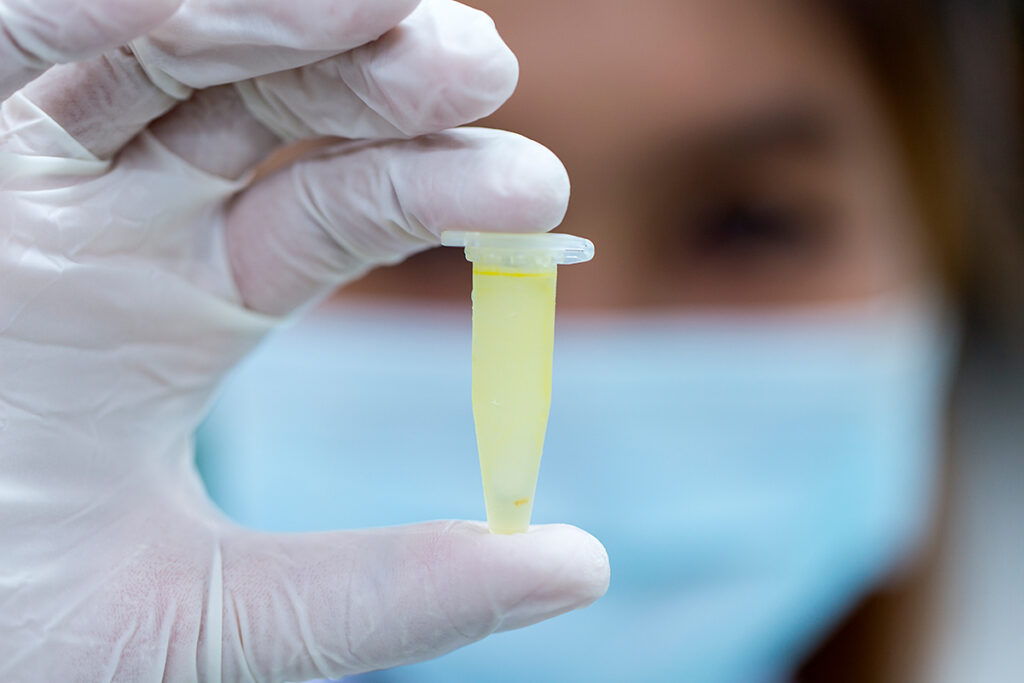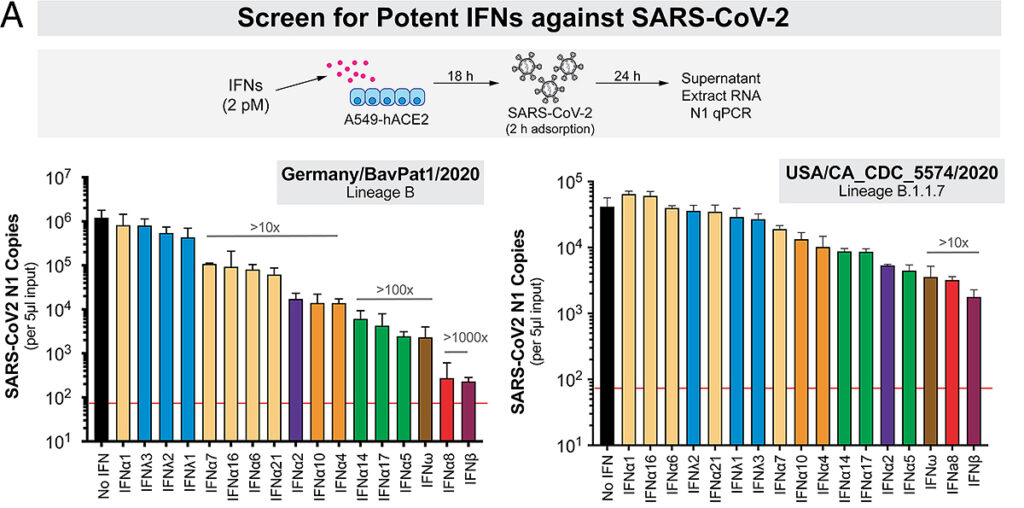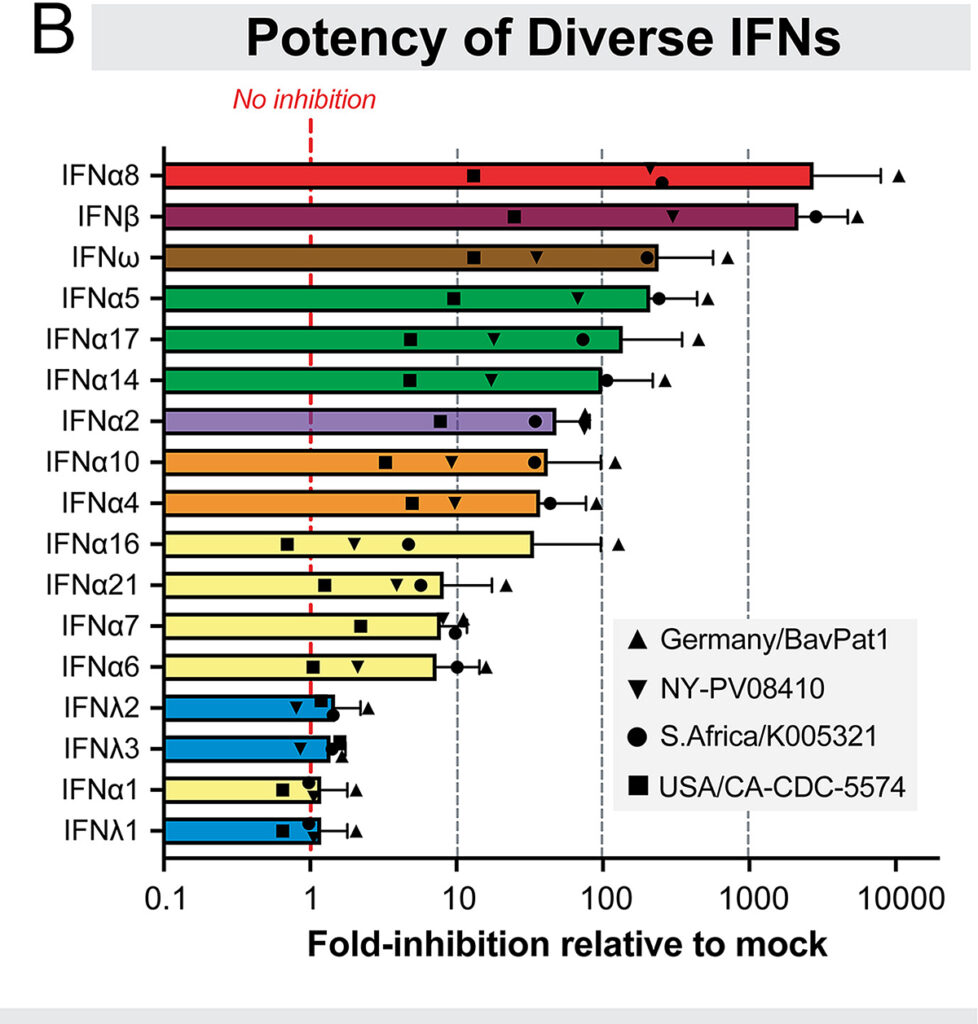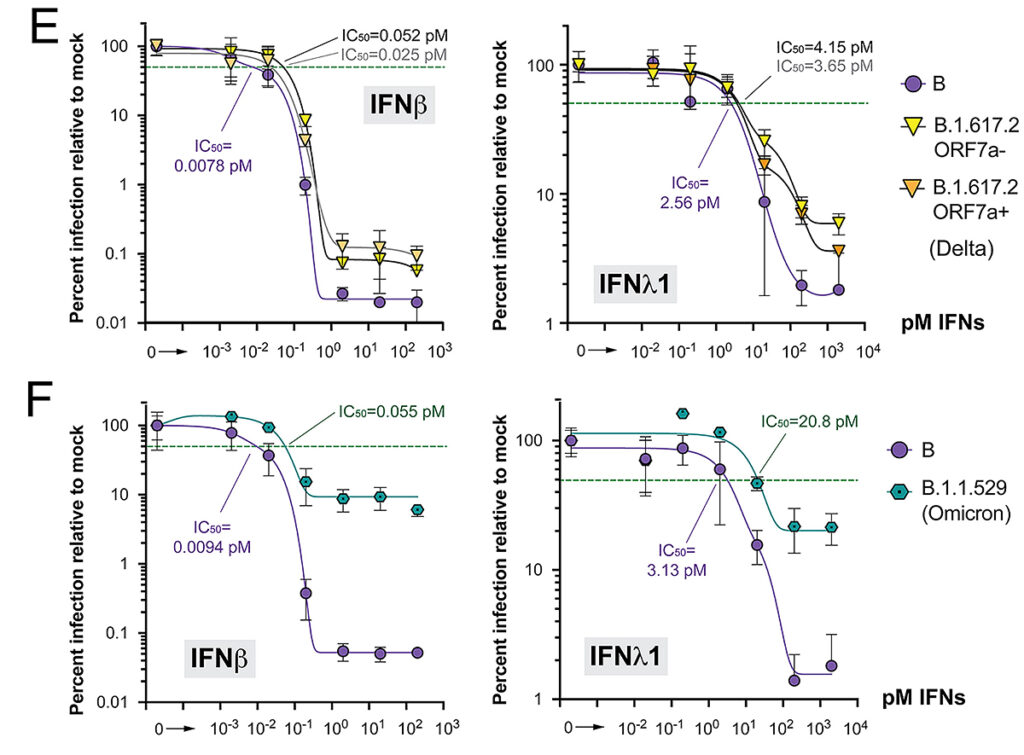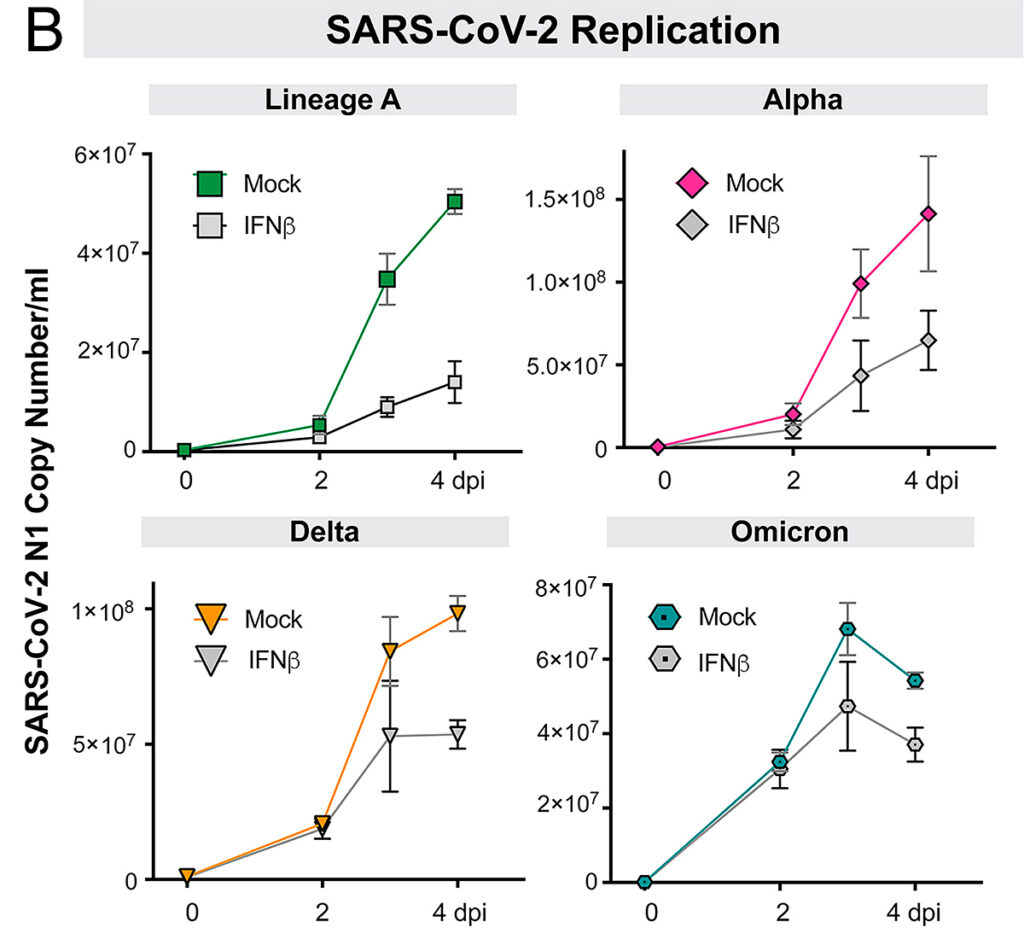Human cells produce various antiviral interferons (IFN). These include type I IFN, among which there are 12 subtypes of IFN-alpha, IFN-beta, and IFN-omega. Type I interferons bind to the IFNAR receptor, which is present on the surface of almost all cells, and trigger an antiviral response.
In addition to IFN-I, cells produce type III interferons – IFN-lambda1, IFN-lambda2 and IFN-lambda3. Type III IFN binds to the IFNLR receptor on the surface of lung epithelial cells.
The diversity of interferons can be explained by the evolutionary arms race between viruses and the body. For example, IFN-alpha subtypes are identical in amino acid sequence by more than 78%, but IFN-alpha14, IFN-alpha8, and IFN-alpha6 most powerfully suppress HIV-1, whereas IFN-alpha5 is most effective in H3N2 influenza. The SARS-CoV-2 coronavirus is sensitive to IFN-alpha2, IFN-beta and IFN-lambda. Clinical trials have shown that IFN-alpha2 and IFN-beta are effective in treating COVID-19.
American scientists compared how effectively different coronavirus strains suppress types I and III interferons. Among the coronavirus strains are Wuhan, D614G, British, South African, Delta, and Omicron. Evolving coronavirus acquired greater contagiousness, resistance to neutralizing antibodies, and the ability to resist the antiviral response of interferon.
Research Results
Different interferons suppress the coronavirus to varying degrees
The scientists used interferons at a concentration of 2 pM. This concentration made it possible to observe the difference in the antiviral effect of interferons, while it did not affect the viability of cells.
Compared to type I IFN, IFN-III showed weak antiviral activity, suppressing the virus by less than 50%.
Image source: https://www.pnas.org/doi/full/10.1073/pnas.2203760119
IFN-alpha8, IFN-beta, and IFN-omega coronavirus were most effectively suppressed. The second most effective are IFN–alpha5, IFN-alpha17, and IFN-alpha14.
Image source: https://www.pnas.org/doi/full/10.1073/pnas.2203760119
To suppress coronavirus by 50%, a 100 times higher concentration of IFN-lambda1 than IFN-alpha2 is needed. In turn, a 14 times higher concentration of IFN-alpha2 is needed than IFN-beta, IFN-alpha5, and IFN-alpha8.
New strains of coronavirus are more resistant to the antiviral response of type I interferon
Due to the low antiviral activity, the scientists excluded type III IFN from the analysis and then compared only 14 type I interferons.
Of the coronavirus strains registered before 2021, the British strain turned out to be the most resistant to interferons compared to the earliest Wuhan strain, by 25-322 times.
Image source: https://www.pnas.org/doi/full/10.1073/pnas.2203760119
The Delta strain was first registered in India in early 2021 and has been dominant since July 2021. The Delta strain was often found in breakthrough infections among fully vaccinated individuals.
By December 2021, Omicron, initially discovered in South Africa, had become the dominant strain. Peak infection levels with Omicron infection are 4 times higher than with Delta strain infection. Omicron is characterized by an extremely high number of mutations in the spike protein. These mutations allow him to bypass the natural and vaccine-formed immunity.
Scientists have studied two variants of the Delta strain of coronavirus – containing the protein ORF7a and not containing. Both variants of the Delta strain were more resistant to IFN-beta (3.2 and 6.7 times) than the D614G strain. The variant of the Delta strain that did not contain the ORF7a protein required a 2.1 times higher concentration of IFN-beta to suppress the virus by 50% than the variant containing the ORF7a protein.
The Omicron strain required 5.9 and 6.6 times higher concentrations of IFN-beta and IFN-lambda1, respectively, to suppress the virus by 50% than the D614G strain.
Image source: https://www.pnas.org/doi/full/10.1073/pnas.2203760119
Omicron and Delta strains are the most resistant to the action of interferons
Scientists experimented on primary epithelial cells of human bronchi using IFN-beta, IFN-alpha2, and IFN-lambda1, which are used in clinical trials to treat patients with COVID-19.
The coronavirus develops to resist the antiviral action of interferons. The experiment showed that the later the SARS-CoV-2 strain appeared, the more resistant it was to all three interferons. Delta and Omicron are in the lead. Moreover, Omicron is most resistant to IFN-beta.
Image source: https://www.pnas.org/doi/full/10.1073/pnas.2203760119
Conclusion
The coronavirus is evolving to become more resistant to the antiviral response of interferons. The antiviral activity of different IFN subtypes varies and depends on the coronavirus strain.
Initially, IFN-lambda was considered an antiviral agent that could reduce inflammation. However, higher doses of IFN-lambda than type I IFN may be required to suppress coronavirus.
IFN-beta is very effective against coronavirus. However, it is associated with a poor outcome in chronic mucosal HIV-1, murine lymphocytic choriomeningitis virus, and, with late administration in mice, in SARS-CoV-1 and MERS-CoV infections. IFN-beta can cause more side effects, as it regulates 2.4 times more genes than IFN-alpha subtypes.
Among the subtypes of IFN-alpha, IFN-alpha8 suppressed coronavirus as effectively as IFN-beta.
The most infectious strain to date is Omicron. It had the highest levels of residual replication at the highest doses of IFN-beta, one of the most potent interferons.
Image source: https://www.pnas.org/doi/full/10.1073/pnas.2203760119
Useful article, necessary information? Share it!
Someone will also find it useful and necessary:
Reference
Interferon resistance of emerging SARS-CoV-2 variants
